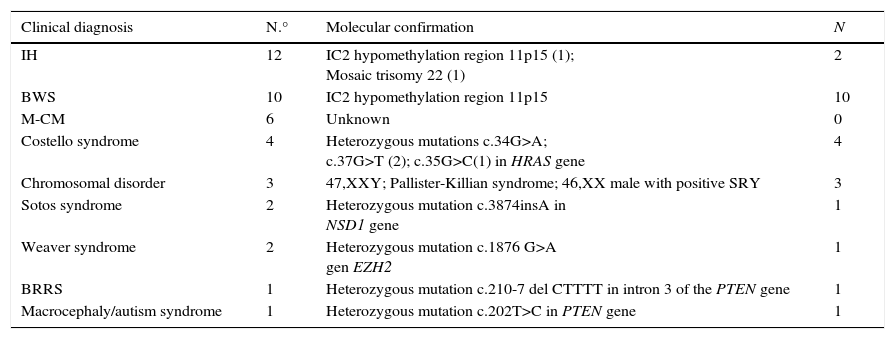Overgrowth syndromes (OSs) comprehend a heterogeneous group of diseases characterised by the presence of global or localised overgrowth that is usually associated with intellectual disability, specific craniofacial anomalies or congenital defects and increased risk of developing embryonic tumours. The revolutionary introduction of next-generation sequencing technology leading to the discovery of new genes and the delineation of new clinical spectra has allowed us to classify this group of diseases into three broad categories1: constitutional single-gene disorders due to germline mutations in a specific gene (Sotos, Weaver, Simpson–Golabi–Behmel, Bannayan–Riley–Ruvalcaba, Perlman syndrome etc.), somatic gene disorders (macrocephaly-capillary malformation, CLOVE syndrome, CLAPO syndrome, etc.) and syndromes secondary to dysregulation of imprinted genes (Beckwith–Wiedemann syndrome [BWS], isolated hemihyperplasia [IH], etc.). On the other hand, several chromosomal disorders2 have been associated with overgrowth in childhood (Klinefelter syndrome, deletion 2p23.3q24.3, deletion 22q13qter, etc.).
In our region, BWS and Sotos syndrome are the most frequent of these diseases, with an estimated incidence of 1/13,700 and 1/15,000 to 1/20,000 inhabitants, respectively. Both are associated with an increased risk of developing tumours, most commonly neural crest tumours, haematologic malignancies and sacrococcygeal teratomas in Sotos syndrome, and Wilms tumour and hepatoblastoma in BWS and IH.1,3 At present, there is no specific protocol for the followup of Sotos syndrome, but follow-up protocols for BWS and IH have been established. Although there is still some debate around it, it is recommended that abdominal ultrasound scans are performed every three to six months until age 7–8 years and measurement of serum alpha-fetoprotein every three months until age 4 years.4–6
We describe the reason for referral, molecular testing and presence or absence of embryonic tumours in 76 patients aged less than 18 years referred in the past five years to the clinical genetics department for suspected OS. Of the total of 76 patients, 72% were referred for suspected BWS/IH (38) or Sotos syndrome (17); the most frequent clinical manifestations in the first group were macroglossia, omphalocoele, hemihyperplasia and overgrowth, and in the second group, macrocephaly, overgrowth and psychomotor delay. Other reasons for referral were suspicion of Costello syndrome (9), Weaver syndrome (5), macrocephaly-capillary malformation (5), Simpson–Golabi–Behmel syndrome (3) and nonspecific overgrowth (6). The patients underwent the following genetic tests (positives/total): karyotyping or CGH array (4/45 [9%]: one Pallister–Killian syndrome, one Klinefelter syndrome, one 46,XX male with positive SRY, one mosaic trisomy 22 in a patient with IH [skin biopsy]); MS-MLPA region 11p15.5 (11/43 [25%]: 10 BWS and 1 IH); MLPA region 5q35 (0/35 [0%]); NSD1 gene sequencing (1/6 [16%], one Sotos syndrome); sequencing of other genes including GPC3 (0/3 [0%]), HRAS (4/8 [50%]: 4 Costello syndrome); EZH2 (1/4 [25%]: one Weaver syndrome); PTEN (2/5 [40%]: one Bannayan–Riley–Ruvalcaba syndrome, one macrocephaly-autism syndrome). Overall, out of a total of 41 cases with a specific diagnosis (54%), the diagnosis was confirmed by genetic testing in 23 (30%). The most frequent diagnoses were IH (12) and BWS (10); macrocephaly-capillary malformation (6); Costello syndrome (4); chromosomal disorder (3); Sotos syndrome (2); Weaver syndrome (2); Bannayan–Riley–Ruvalcaba syndrome (1), and macrocephaly-autism syndrome (1). The rest were classified as nonspecific overgrowth of unknown aetiology or seemingly isolated defects (omphalocoele, macroglossia, etc.) (Table 1).
Specific clinical diagnoses and molecular confirmation.
| Clinical diagnosis | N.° | Molecular confirmation | N |
|---|---|---|---|
| IH | 12 | IC2 hypomethylation region 11p15 (1); Mosaic trisomy 22 (1) | 2 |
| BWS | 10 | IC2 hypomethylation region 11p15 | 10 |
| M-CM | 6 | Unknown | 0 |
| Costello syndrome | 4 | Heterozygous mutations c.34G>A; c.37G>T (2); c.35G>C(1) in HRAS gene | 4 |
| Chromosomal disorder | 3 | 47,XXY; Pallister-Killian syndrome; 46,XX male with positive SRY | 3 |
| Sotos syndrome | 2 | Heterozygous mutation c.3874insA in NSD1 gene | 1 |
| Weaver syndrome | 2 | Heterozygous mutation c.1876 G>A gen EZH2 | 1 |
| BRRS | 1 | Heterozygous mutation c.210-7 del CTTTT in intron 3 of the PTEN gene | 1 |
| Macrocephaly/autism syndrome | 1 | Heterozygous mutation c.202T>C in PTEN gene | 1 |
BRRS, Bannayan–Riley–Ruvalcaba syndrome; BWS, Beckwith–Wiedemann syndrome; IH, isolated hemihyperplasia; M-CM, macrocephaly-capillary malformation.
A comparison of the indications for referral (72% for suspected BWS/IH or Sotos syndrome) with the specific diagnoses made in our population (57%) evinces the complexity of these disorders and the overlap in their clinical manifestations, as well as the importance of the assessment by a clinical geneticist for their adequate characterisation.
None of the patients with BWS (10) due to IC2 hypomethylation in the 11p15 region or with Sotos syndrome (2) developed tumours during followup. The mean duration of followup was three years, which may have biased the results. One in twelve (8.3%) patients with IH and an unknown genetic defect developed paravertebral neuroblastoma at 16 months, which supports the recommendation of using a follow-up protocol in these patients.4 We ought to highlight that two children with overgrowth of unknown aetiology developed a Wilms tumour and a lymphatic malignancy that required radiation, respectively, before age 3 years. This suggests that even if the underlying genetic defect is not known, we must keep in mind the association between these syndromes and the development of embryonic tumours.
In conclusion, overgrowth syndromes constitute a heterogeneous group of diseases that carry a high risk of developing tumours in childhood, and therefore paediatricians need to be knowledgeable on this area. The early characterisation of these syndromes by clinical geneticists can guide genetic testing, allowing specific genetic counselling and close monitoring of patients with BWS and IH consisting of the performance of abdominal ultrasound scans every three to four months until age 7–8 years and measurement of serum alpha-fetoprotein every three months until age 4 years, independent of the specific underlying genetic defect.4,6
Please cite this article as: Sánchez-Soler MJ, Tenorio J, García-Miñaur S, Santos-Simarro F, Lapunzina P. Síndromes de sobrecrecimiento y desarrollo de tumores embrionarios: revisión de nuestra casuística en los últimos 5 años. An Pediatr (Barc). 2016;85:104–105.




